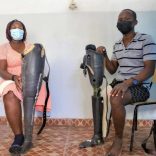Mozambique: Cabo Delgado needs $1.2M to tackle rainy season impacts - INGD
Health budgets per capita are below national average in provinces home to 77% of population – OCS | Mozambique

Image: OCS
The State Budget for 2021 was approved by the Assembly of the Republic on November 4, 2020, with a global budget of 368 billion meticais, corresponding to US$4.9 billion [16-02-21 exchange rates], 65% of which goes to operating expenses, 23% to investment and 13% to financial operations.
The 2021 State Budget was prepared taking into account one of the priorities defined by the Government – the allocation of resources for the realisation of public expenditure, in accordance with the strategic actions of the Government’s Five-Year Plan (PQG) 2020-2024. Under this, the Health, Education, Agriculture and Rural Development sectors constitute priority areas, and together receive resources with a combined weight in the State Budget of around 47%.
For the present year of 2021, MZN 37.4 billion (US$0.5 billion) from the State Budget has been allocated to the health sector. The amount in question represents 14% of the proposed budget for 2021, with the exception, however, of financial operations and debt service, including government charges. The resources allocated to the health sector represent an increase of 5.6% in relation to the revised allocation in 2020, as well as an increase of 59% in relation to health expenditure in 2019.
Between 2008 and 2017, health sector expenditure increased from MZN 7 billion in 2008 to MZN 15.5 billion in 2012, reaching 20 billion in 2013, essentially as a result of donor funds, driven partly by introducing new products such as vaccines. This translated into a high real growth in health expenditure. In the absence of high funds from donors, growth was negative in 2014. Thereafter, expenditure in nominal terms has shown a slow growth trend (from MZN 18 billion in 2015 to MZN 20 billion in 2016), although in real terms, expenditure decreased in 2016 due to high inflation (19.9%).

Central health sector administration receives just over half of all the funds allocated to the health sector
For the current financial year, the central administration was allocated just over half of the total funds allocated to the health sector, followed by primary and secondary health care, provincial administration, quaternary health care, and tertiary health care .
The central administration, comprising the Ministry of Health (MISAU), the Regional Centre for Health Development (CRDS), the Centre for Medicines and Medical Articles (CMAM) and the National Institute of Health (INS), was allocated an amount in the order of MZN 19.3 billion, corresponding to 51.6% of the sector’s total budget. It is important to mention that 62% of this amount goes to operating expenses and 38% to investment.

In the last decade, central level institutions have absorbed an average of 59% of the sector’s spending. In turn, institutions at provincial level absorbed an average of 29%, while those at district level absorbed an average of 12%. However, in more recent years, allocations to districts have generally been much higher than those at provincial level (UNICEF, State Budget Proposal for Fiscal Year 2019: Analysis of the Economic and Social Sectors Mozambique 2019).
Primary and secondary health care, which are provided by SDSMAS and district hospitals, together received an amount of MZN 7.6 billion, equivalent to 20% of the budget. The provincial administration, which is exercised by the DPS, was allocated MZN 3.8 billion, corresponding to 10% of the budget. Quaternary health care, which includes central hospitals and psychiatric hospitals, received MZN 3.1 billion, the equivalent to 8% of the budget.
Tertiary health care, which is provided by the general and provincial hospitals, receives 2.3 billion MZN, corresponding to 6% of the sector’s total budget. Finally, the research and teaching area, which is carried out by the Institutes of Health Sciences, receives the lowest amount, MZN 0.2 billion, the equivalent to 0.5% of the sector’s total budget.
The level of priority spending in the country has seen significant increases in recent years. However, it is important that efforts continue to be made to increase the proportion of resources for the sector, in order to achieve the internationally agreed targets.

Maputo receives highest per capita public investment health
The funds allocated to the health sector are allocated at different levels to institutions with autonomy to receive and manage the funds in question.
Taking into account the health sector budget for 2021 as a whole, the budgeted amount corresponds to a per capita allocation (per person) of MZN 1.3 thousand (US$17.1). When the expenses with the Central Administration are excluded, the per capita expenditure decreases to about half, standing at MZN 0.68 thousand (US$8.8).
According to the Monitoring and Budget Forum (FMO), the per capita allocation in Health showed that in the last five years, for each citizen, only US$14 were spent annually (which calls into question the improvement of Human Development indicators), while the WHO suggests that countries should spend just over US$60 per inhabitant on health services.
However, looking at the total envelope of resources allocated to institutions within each province, there is a large deviation in the per capita budget between provinces. Indeed, regarding the sector’s per capita budget for the provinces of Zambézia, Nampula, Tete, Gaza, Niassa, Manica and Cabo Delgado, it is noted that the figures are lower than the national average of MZN 0.32 thousand, in contrast to the sums found in the provinces of Inhambane, Sofala and Maputo, which are above the national average per capita.
Therefore, a massive increase in investment in the health sector is shown to be necessary to strengthen specific interventions in the provinces, in order to combat more deadly and more disabling diseases, as well as to strengthen care delivery systems. primary health care for populations, especially the most disadvantaged and vulnerable.


In the particular case of Maputo province, the budget resources allocated to it are more than twice the average of the country’s per capita budget.
When compared to the other provinces, it appears that, at a disadvantage, are, namely, the provinces of Nampula and Zambézia, compared to the per capita budget of Maputo, which is 6 to 7 times higher than that of those other geographic districts.
Despite the fact that the provinces of Nampula and Zambézia have a larger territorial extension, with a high population density (Nampula has 5,483,382 inhabitants and Quelimane 5,002,457 inhabitants), their respective Central Hospitals absorb a considerably reduced volume of financial resources, when compared to Maputo Central Hospital, which is allocated an average of MZN 1,650.79 million per year, just over 53% of [all] the funds allocated to [all the] Central Hospitals [in Mozambique].
The severity of the sharp deviation from the per capita budget becomes more evident when one takes into account the size of the population that inhabits each of the provinces considered in the analysis.
In fact, taking into account the most recent population data, provinces with a per capita budget below the national average are home to 77% of the country’s population, while the remaining 23% reside in areas that benefit from resources above the per capita average.
However, the country still lives with the contradiction where, due to the deficit in the provision of services, the population tends to pay the expenses related to health services (to obtain certain medications, medical exams and treatments), despite the SNS being ‘free and universal .
This reinforces the argument that the increase registered in the amounts allocated from 2012 to 2017 was not sufficient to guarantee the improvement in the quality of health services provided to populations.
- This text uses the exchange rate of 1 USD = 74.42 MT, which corresponds to the rate registered onFebruary 16 2021, , information available: http: //www.bancomoc.mz/fm_mercadosmmi.aspx? Id = 10












Leave a Reply
Be the First to Comment!
You must be logged in to post a comment.
You must be logged in to post a comment.